![]()
|
|
| Ghettos. That word sends chills up and down some people spines. Especially the Jews that survived there terrible places. You need to know what a Ghetto is like before you can actually understand all of the Holocaust. |
| The Riga Ghetto. It was placed in one of the poorest neighborhoods in Riga, the Maskavos Suburb. 19% of the Jews already lived there. That was 9,805 Jews. On October 1941 a fence was put up around the Ghetto. It eventually became a double barb wire fence. If you went near it you were shot onsite. The Jews weren't allowed to bring anything into the Ghetto except personal items, cloths, and simple household furniture. There was a hospital in the Ghetto with very scarce medical supplies. There were also schools and soup kitchens. Jews had to find their own home in the Ghetto. That meant sharing a home with other families. The suburb was originally designed for 13,000 people, but the Germans put 29,602 Jews in the Ghetto. On November 27,1941 the Jews were told that they would be shifted further east. They didn't know that they were going to the Rumbuli Forest, where 15,000 of them were going to be shot. After that took place, a smaller Ghetto was established for younger men. On December 8,1941 the same horror was repeated. 10,000 deaths took place in the forest. The mission to kill all of the Latvian Jews, with some exceptions, had been completed. |
| The Minsk Ghetto was surrounded by five strand of barb wire. Anyone who went beyond the wire was shot. "You couldn't go, you were bound to stay for your execution." said Yala Korwin. Jews were forced to do heavy labor. They had to dig without shovels. The Jews were given 300 grams of bread once a day. They were also given a dark watery substance that the Germans called soup. On November 7,1941 a major pogrom took place. 13,000 Jews were taken into Tuchink and brutally killed. Another massacre took place on November 20,1941, in Minsk. 7,000 Jews were killed that day. At the end of March 1942 a new wave of pogroms began. They occurred on March 31,1942 and April 3,1942. By October 1,1943, 2,000 Jews remained in the Ghetto. On October 21,1943, the Gestapo surrounded the Ghetto again. All of the remaining Jews were loaded into trucks and taken away. Buildings were blown up in case someone was hiding in them. Only the ruins would bare witness to the horrible and inhuman crimes committed to tens of thousands of Jews of the Minsk Ghetto. |
| The Lodz Ghetto was set-up in Twoof, the most neglected districts in Lodz. It was established February 1940. The area had 31,721 apartments. Most were only a single room without running water. 160,000 Jews were crammed into this dismal neighborhood. Between May of 1940 and the end of 1940, 6,500 Jews would die. | 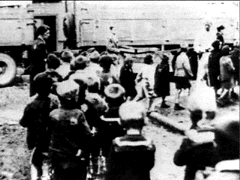
 Children being sent to their death A child eating a meal |
| The Nazis mapped out a Ghetto in Czernowitz, and ordered 50,000 Jews to move into it within the next eight hours. Traian Popovicz, the Mayor of the city, recorded what happened. "I look outside the window of my bedroom and amidst the flying flakes of the early snow I saw a scene which was incredible. In the streets was a vast crowd of wandering people. The aged were helped by children, there were women with infants in their arms, cripples dragging their lame frame. All had bundles in their hands or were pushing small carriages loaded with boxes. Some carried their burden on their backs: luggage, bundles of linen, cushions, blankets, clothing, rags. They were beginning their mute pilgrimage to their bale of tears, the Ghetto. Only one who knows the topography of Czernowitz can grasp how inadequate was the space reserved for the Ghetto... This section that could hardly have accumulated 10,000 people had to house 50,000 Jews plus the Christian population which lived there... many were forced to live in corridors, cellars, garages, under bridges, anywhere to find shelter against snow and rain. Of the hygienic conditions I don't even speak. Now sanitary water to drink... the pungent smell of sweat, urine, and excrement, of loathsome humidity... exactly like the smell of a flock of sheep in the field" Ludwik Hirszfel asked a little girl "What would you like to be?" "A dog," she answered "because the Sentries like dogs." The reason most Jews were starved is because it was cheaper than shooting them. W. Szpiliman saw something terrible in the Ghetto one day, as he was walking along the inside wall, he described it. "I came across a smuggling operation being carried out by children. The actual operation seemed to be over. There was only one thing to do. The little Jewish boy on the other side of the wall had to slip back into the Ghetto through the hole, bringing with him the last piece of booty. Half of the little boy was already visible, when he began to cry out. At the same time loud abuse in German could be heard from the "Aryan" side. I hurried to help the child, meaning to pull quickly the hole. Unhappily, the boys' hips stuck fast in the gap of the wall. Using both hands, I tried with all my might to pull him through. He continued to scream dreadfully. I could hear the police on the other side beating him savagely. When I successfully succeeded in pulling the boy through the hole, he was already dying. His back bone was was crushed." |
| The Nazis invaded Poland on September 1939. By October 1940 they confined almost 400,000 Jews in a 3.5 sq. mile space in Warsaw which normally housed 160,000 people. The area was surrounded by a 10 ft. wall, and was sealed off on November 15,1940. They couldn't leave or they would be shot. The Jews were given one bowl of soup a day. Around 300 to 400 people died each day of starvation and disease. The Germans wanted to kill all of the Jews so, to get rid of them all, they burned down the entire Ghetto. A report filed by Stoop described the scene. "The Jews stayed in burning building until, because of the fear of being burned alive, they jumped from upper stories... With their bones broken they still tried to crawl across the street into buildings which had not yet been set on fire... Despite the danger of being burned alive the Jews and bandits often preferred to return into the flames rather than risk being caught by us." The burnings and German attacks continued, but the Jews in Warsaw resisted for a total of twenty-eight days. |
Starving children in the Warsaw Ghetto
Starving Poles carve up a dead horse. |
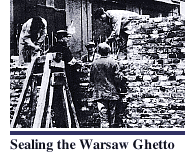 |
|
| Theresienstadt had been remembered for it's culture, it's famous prisoners, and it's visitor from the Red Cross officials. It was really a concentration camp holding nearly 60,000 Jews. The area was originally designed for 7,000 people. A lot of elderly thought that they were going to a resort or spa. Some even paid large sums of money for a nice location within their new home. When they arrived they were put in the same small house, if not smaller, as everyone else. The houses contained triple-tiered bunk beds. Every available floor space was used. Bye August 1942 the allotted space per person was two square yards- included usage needed for lavatory, kitchen, and storage space. The living/sleeping area was covered with vermin like rats, flies, and lice. Nobert Troller wrote about his experiences; "Coming back from such surveys (of the house) our calves were bitten and full of fleas that we could only remove with kerosene." The housing was separated by gender. Women and children under 12 were separated from men and boys over 12. The reason why it was called the "Model" Ghetto is: The Danish Red Cross was suppose to visit the Ghetto. They were going to make sure that the Jews were living in humane conditions. The Germans planned the exact route that the Red Cross would take. All of the buildings and ground would be enhanced by green turf, flowers, and benches. A playground, sports field, and a monument were also added. Prominent and Dutch Jews had their billets enlarge, as well had furniture, draped, and flower boxes were added. The commander of Theresienstadt, SS Colonel Karl Rahm, ordered 7,500 inhabitants to be deported. They decided that the orphans and most of the sick should stay and be included in the facade that they were making. They put two signs over a building that read "Boys school" and "Closed during holidays." On June 23,1944 the commission arrived. Well rehearsed actions took place as the tour commenced. A load of fresh vegetables were being delivered, bakers were baking bread, and workers singing were all queued by messengers who ran ahead of the tour. After the visit, the Nazis were so impressed with what they did that they decided to make a film. |
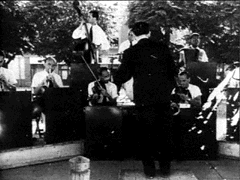
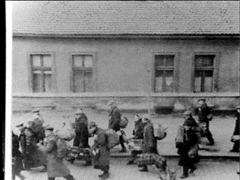
 Band playing for the Red Cross Jews being deported to the East A view of the Theresienstadt Ghetto |
| There were Jewish police in each Ghetto. The Jewish administration answered to a German commander, who answered to a General Government, a Nazi created administrative area that covered all of central Poland. Most of the Ghettos had a thing called ration cards. A ration card is a card that Jews had to buy to have food. They cost ten groszy (pennies) for each card. Even though times were hard in the Ghettos they still managed to build a school. Jewish teachers started them. The Ghetto life was difficult. Ghettos were filthy, extreme overcrowding, staying warm was difficult during the bitter cold winter. They didn't have warm clothes, and they didn't have heating fuel. There was hardly any food and the Jews slowly starved to death. |
| Five major Ghettos were located in Warsaw, Lodz, Krakow, Lublin, and Lvov. Eight major Ghettos were 1. Bialystok (Poland) 2. Kovno (Lithaunia) 3. Lvov (Poland) 5. Minsk (Belorassia) 6. Riga (Latvia) 7. Vilna (Lithaunia) 8. Warsaw (Poland) In total there were 365 Ghettos in Poland, the Soviet Union, the Baltic States, Czechoslovalcia, Romania, and Hungary, between 1939 and 1945. Pitrokow was the first Jewish Ghetto. It was established on October 8,1939. On May 1,1940 the Ghetto was sealed. The smallest Ghetto housed about 3,000 people. The Largest, Warsaw, housed about 400,000 people. The second largest, Lodz, held approximately 160,000 people. | ||||||||||||||||||||||||||||||||||||||||||||||||||||||||||||||||||||||||||||||||||||
|
||||||||||||||||||||||||||||||||||||||||||||||||||||||||||||||||||||||||||||||||||||
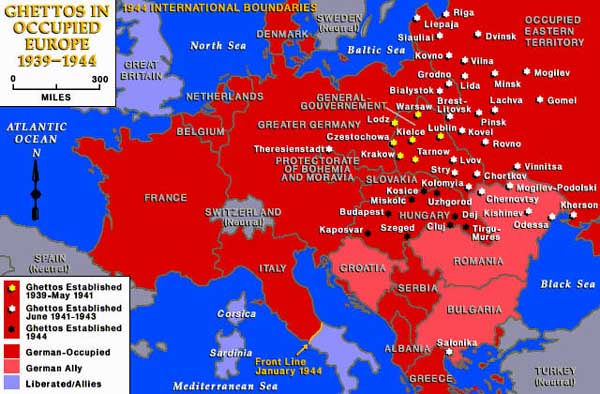
This is a map of the Ghettos in Germany between 1939-1945. |
| Now do you understand how they were brutally beaten, killed, starved, and so much more. Even though most died, there are some survivors. Now they live to tell their tale about the terrible and unforgettable Ghettos. |
|
Angelique Flinn 7th Social Studies Rossville Jr. High Holocaust Project 2004 |